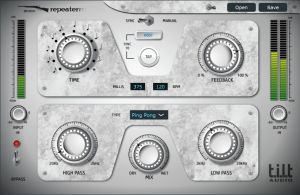KVR Developer Challenge 2018KVRDC18: Tilt Audio Mono Repeater - Delay Plug-in for Mac & Win

With the KVR Developer Challenge 2018 at the download and voting stage it's time to focus on each of the 26 entries that are available now, for free, for everyone.
 Mono Repeater by Tilt Audio
Mono Repeater by Tilt Audio
Mac & Win; VST2, VST3 & AU
Mono Repeater is a classic digital delay simulation of an analog tape delay. The application was designed and written by Tilt Audio, a moniker of Akash Murthy, an audiophile and enthusiast.
The interface helps the user dial in the perfect delay, ranging from a subtle ambient reverb effect, to full blown in-your-face echo box. It boasts a wide range of tempo selection options to dial in the perfect delay time setting when recording or playing to a click track.
Parameters and functions:
- Delay Time: is measured in milliseconds and ranges from 30 to 4000ms. Delay time can also be measured in beats (quarter, triplet, half, full, etc) when the selection switch is toggled to Sync. This syncs to an internal clock which can be determined by a manual BPM selection, tap tempo selection or host BPM selection.
- Feedback: determines the time taken for the delayed signal to fade out. At 0% the signal is only repeated once, while at 100%, the signal is repeated infinitely with no attenuation. Care should be taken when using this setting close to 100%, since it can cause feedback loops easily while playing out loud and can potentially overload the output device.
- High Pass: or Low Cut, determines the low cut off frequency of the high pass filter. It uses a classic 2nd order Butterworth IIR design. Use this to reduce the bass or low end of the delayed signal. Range: 20 - 2kHz.
- Low Pass: or High Cut, determines the high cut off frequency of the low pass filter. It uses a classic 2nd order Butterworth IIR design. Use this to reduce the shrillness or high end of the delayed signal. This setting is especially useful when used with string or percussive instruments to drown out the ring or attack sound. Range: 2k - 20k Hz.
- Mix: determines the amount of input signal vs delayed signal that is routed to the output.
- Type: currently supports two delay modes. Digital is the classic delay mode in which the mono signal is split into two stereo channels. Ping Pong delay offers a wider stereo spread where the signal bounces from one channel to the other.
- Host Selection Switch: Toggle this on to receive BPM information from the host application. If used as a standalone application, this is hardcoded to 120 BPM.
- Tap: lets you tap in the time by clicking on the tap button several times trying to hold a steady quarter note beat. The BPM can be finely adjusted by clicking and dragging on the BPM box or by entering a specific value.
- Performance Switch: is the unnamed switch on the top left which turns of metering and decreases the overhead required to run the plugin. If the plugin experiences sluggish use due to many plugins running simultaneously, use this in the Off setting.
Download, vote & donate at www.kvraudio.com/kvr-developer-challenge/2018
If you haven't read it already, you should check out the KVRDC16 winner's story: Winning the KVR Developer Challenge: An interview with Julijan Nikolic (Youlean)



 Other Related News
Other Related News

